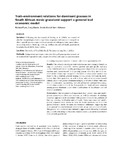| dc.description.abstract | Question: Following the framework of Suding et al.(2003), we examined whether morphological traits (organismal response), tolerance and competitive effect (specific process response) were associated with grass dominance (abundance response) on burning, mowing, fertilization and soil depth gradients in KwaZulu-Natal (KZN), South Africa.
Location: University of KwaZulu-Natal, Pietermaritzburg, South Africa.
Methods: Using several pot experiments involving 29 grass species in total, we determined the vegetative traits, competitive effect and response, and tolerance to shading for grasses common in closed, tufted mesic grassland in KZN.
Results: The primary axis of grass–trait variation was most strongly related to a negative correlation (trade-off) between growth rate and specific leaf area (SLA), with broad-leaved, rapidly-growing grasses (high SLA) occupying one extreme and narrow-leaved, slow-growing grasses (low SLA) the other extreme of the first principal component. The low SLA, slow-growth strategy was found to be a relatively general strategy among grasses dominant in undisturbed, high litter grassland, as well as those adapted to moisture-stressed habitats. In contrast, grasses dominant in highly productive habitats with some form of disturbance, e.g. mowing, had a broad-leaved, rapid-growth strategy. Intermediate combinations of the SLA–growth rate trade-off were common among grasses dominant under other combinations of disturbance and soil resource availability.
Conclusions: Distinct patterns of organismal (SLA, growth rate) and specific process (competitive effect and response, as well as tolerance of shading) responses appeared to be associated with grasses dominant on gradients of burning, mowing, fertilization and soil depth. These organismal and specific process responses were similar to those for North American and European grasses dominant under the same environmental influences, suggesting that some general trait–environment patterns exist at an inter-continental scale. This general trait–environment relationship appears to be driven by functional adaptive selection along the SLA–environment continuum and its unavoidable trade-off with growth rate. | en_US |

